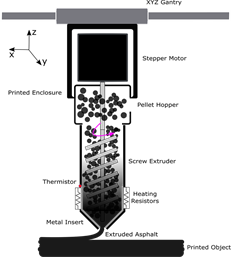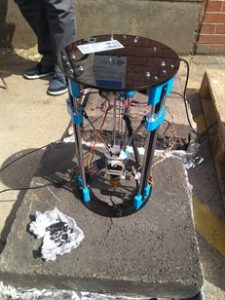Purdue University researchers 3D print bacteria grabbing colonoscopy capsules
Pakistani researchers use FDM 3D printing to create tablets with enhanced dosage control
UCL researchers 3D print abuse-deterrent opioid tablets
Pharmaceutics special issue details the 3D printing of drug delivery devices
FabRx 3D prints personalized tablets for treatment of rare metabolic disease in children
ecoLogicStudio & partners showcase 3D printed in-human gardens at Centre Pompidou
3D Printing News Sliced: Rocket Lab, David Bowie, Resident Evil 2
Self Repairing Cities Project Continues to Make Progress with Flying Road-Fixing 3D Printers
The holiday season is here…and so is the season for terrible roads. Snow and ice will be ruling the roads for the next few months, and when they go, they will leave behind them potholes and cracks. Time to get the road crews out, resulting in further frustration as traffic flow is disrupted to fix the damage.
It’s a cycle that most people are used to, but it may not be the case forever. The Self Repairing Cities project is working to create a future in which drones repair road damage, using attached 3D printers to deposit asphalt into cracks and holes. The University of Leeds has already created a prototype of a road repair drone, and researchers at University College London have developed the world’s first asphalt 3D printer.
“Our 2050 vision is to have zero-disruption road works,” says Richard Jackson, a research associate at UCL who developed the asphalt 3D printer. “It will be quieter, so we can do it at night and the goal is to have no human input at all.”
Before the project reaches that stage, it may be deployed in a semi-automated version of the process, which several road contractors have already expressed interest in. For example, a logistics app could direct a small repair crew to crack locations, possibly in an automated vehicle, optimizing the work schedule, timing and routes. The crew would bring a “black box” which would use computer vision technology to position a 3D printer over the crack and fill it.
Not only would using drones to repair roads be less disruptive to traffic, it would be much less expensive than using human crews, according to Jackson. The idea is to repair small cracks before they can develop into full-blown potholes. Road surfaces would be continually scanned, using devices attached to the underside of municipal vehicles such as garbage trucks, and cracks would be treated soon after being identified. Using GPS, drones could be deployed to the sites of cracks, equipped with exactly the right amount of asphalt to treat each crack.
More research is required, according to Jackson, to figure out how the crack would be prepared for repair; it would need to be cleaned out and some sort of agent applied to help form a good bond between the repair material and the road surface.
“As scientists, we like to ask questions like ‘could we put a flame thrower on a drone?’” says Jackson. “And after the asphalt has been printed, are we going to compact it, or will each function be carried out by a different drone?”
 The 3D printer that Jackson designed is a three-axis system with individual stepper motors that move the printer nozzle, which is made up of an auger screw, a stepper motor to drive the screw and a pellet hopper that feeds the asphalt pellets. The pellets are warmed by heating resistors and turned into liquid as they pass through the nozzle.
The 3D printer that Jackson designed is a three-axis system with individual stepper motors that move the printer nozzle, which is made up of an auger screw, a stepper motor to drive the screw and a pellet hopper that feeds the asphalt pellets. The pellets are warmed by heating resistors and turned into liquid as they pass through the nozzle.
When Jackson tested the 3D printer, he compared 3D printed bars of asphalt to cast ones and discovered something surprising: the printed bars had up to nine times the ductility of the cast ones, with similar fracture strengths. Under closer observation, it was discovered that the 3D printed asphalt had a stretchy brown substance throughout its cross-section, unlike the cast samples. Jackson thinks that that the brown substance is composed of a lighter saturated faction of the asphalt that formed due to the way various sizes of particles move during heating and extrusion process.
“I have done some other work involving nano-fibres and the printing process influences the fibres quite strangely too,” he said.
Jackson is now working on 3D printing asphalt mixes, and while there is some trouble printing aggregate material at a small scale, mixtures of sand and asphalt can be printed. 3D printing would allow the material to be varied over the depth of the crack, with feedstock switched out to apply a different material at the bottom and the top. Jackson is also adding nanomaterials such as titanium dioxide nano particles. This will allow for printing materials to be customized for different locations. The operating parameters of the 3D printer could also be adjusted.
“There is an argument for machine learning in the design,” said Jackson. “We need a factory to make the 3D printing robots with different properties depending on the materials used in the road.”
 In a separate project, researchers at Texas A&M have been working with 3D printing to repair spall damage, which happens when lumps of concrete in concrete roads break off around cracks. Jaeheum Yeon from the university’s Department of Engineering and Technology said that he and colleagues Julian Kang from the Department of Construction Science and Wei Yan from the Department of Architecture were inspired by dental technology to 3D print concrete patches for the spall damage.
In a separate project, researchers at Texas A&M have been working with 3D printing to repair spall damage, which happens when lumps of concrete in concrete roads break off around cracks. Jaeheum Yeon from the university’s Department of Engineering and Technology said that he and colleagues Julian Kang from the Department of Construction Science and Wei Yan from the Department of Architecture were inspired by dental technology to 3D print concrete patches for the spall damage.
“The use of laser scanners and 3D printers to treat cavities also has implications for engineers in concrete road maintenance,” said Yeon. “This method of treating cavities using 3D printers can be used to repair spall damage on concrete roads.”
The researchers used photogrammetry software to create a computer model of the spall damage, which was then used to create a plastic formwork into which concrete was poured. The patch was then glued into the hole. This technique has been used for two holes in the university’s parking lot. The longevity of the technique still needs to be proven before using it on roads, but the researchers believe that it could be used to repair holes in two days rather than the usual seven, as well as reducing costs from $140,000 to $1,700.
Discuss this and other 3D printing topics at 3DPrintBoard.com or share your thoughts below.

